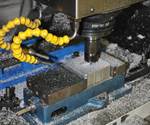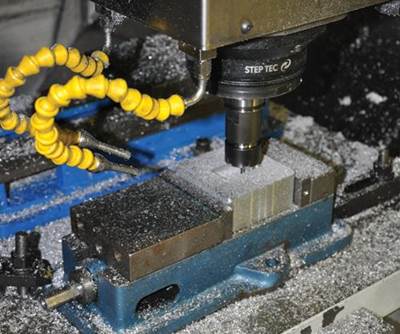Why Offer Aluminum Molds for Production
While not often mentioned as a mold material, using aluminum for molds allows moldmakers to offer customers reduced costs and leadtimes.
Aluminum molds have always been considered "soft" tooling, and discussion of using them for high volume production has been considered taboo. That mindset has stifled the ability of molders - and their customers - to take advantage of the many benefits of aluminum to provide quick turnaround times, faster cycles, lower costs and in many cases, higher quality for their injection molded plastic products.
In late 1991, IBM (International Business Machines) formally announced that they had completed a five-year study of using aluminum molds for high volume production. This study demonstrated that - compared to identically designed-and-built tool steel molds - aluminum molds cost 50 percent less, were delivered in half the amount of time and produced higher quality products during cycle times that were reduced by 25 to 40 percent. This data was compiled for a number of molds and various product designs, using a variety of plastic molding compounds - some with glass loadings as high as 40 percent.
Although this information proved staggering at the time, the real shock came when it was discovered that the molds were still producing parts after as much as two million cycles. This literally blew apart the age-old concept that aluminum molds were not tough enough to withstand the rigors of high volume, long-term production runs of injection-molded products.
Since that announcement, many other companies have come forward to admit that they, too, had experienced the savings in time and money available through use of aluminum molds for production purposes. For a while, the plastics journals were filled with first-hand accounts of such successes.
What became obvious was that many molders had been using aluminum molds for production purposes for years, but were hesitant to let others know - especially their customers - because of the "soft tool" stigma that had been placed on aluminum molds for so long. In fact, use of aluminum molds allowed many companies to undercut total production costs, thereby giving them a leg up (albeit an unethical one if the customer was paying for steel) on their competition.
It should be stated that aluminum may not be the best choice for every application and someone familiar with the advantages, disadvantages, costs, contacts and basic concepts involved with using aluminum molds should study each situation. But, that being said, there are few cases that would not benefit from aluminum molds.
It also must be stated that only certain grades of aluminum are capable of being machined properly - and of withstanding the pressures involved with injection molding. As for cost, the aluminum is usually three times the cost of tool steel by weight, but it is 1/3 the weight of tool steel, so the initial cost is the same for both.
Wear and Hardening Issues
One question arises frequently: Does the aluminum wear faster than steel and does it require hardening? In fact, aluminum wears better if it is not hardened. This is due to the nature of the material to "even out" the microscopic molecular hills and valleys on the surface over time in use. Instead of galling, aluminum surfaces slide. But many users do utilize some type of hardening through anodizing or other surface treatment. Anodizing can produce a surface hardened up to a Rockwell C of 65. This is accomplished by converting up to 0.002 in. of the aluminum surface to an oxide and adding an additional 0.002 oxide to that surface for a total of 0.004 in. hardened layer.
A word of caution though regarding anodizing: it will chip away from corners that are 90 degrees or less. While this can be repaired by removing the anodized finish and re-anodizing, it is not a cost-effective remedy. Also, the anodizing process will form a layer approximately 0.004 in. thick. Half of this will be embedded in the aluminum and half will "grow" on top of the surface. This must be taken into consideration when machining cavities.
There are other methods of hardening the surface of aluminum. One of the most popular is a method - provided under many different commercial names - which incorporates a Teflon" material in a nickel base. This is applied to the surface and can be stripped and re-applied as necessary. You can get more information from moldmakers that specialize in aluminum molds.
Machining and Polishing
Experience has shown that the best grade of aluminum to use is "aircraft" quality. This is known as a T-6 grade (7075) and does not gum up cutters and grinders. It can be welded, and EDM (plunge and wire) can be used for machining. Aluminum will machine at speeds approximately four times faster than mold steel and two to three times faster than prehardened P-20. The surface can be polished using standard procedures with a fewer number of steps due to the immediate smoothing ability of the aluminum microstructure.
Because it is so light, aluminum can be machined on smaller equipment, and at faster feeds. The more contoured the surfaces, the more savings available using aluminum because of the fast speeds and heavy feeds that can be used.
Cycle Time Reduction
Because aluminum dissipates heat up to seven times faster than steel, molding cycles can be reduced by 20 to 50 percent. This heat dissipation is very uniform, which results in parts that retain excellent dimensional stability because there is less tendency to distort due to shrink differences. The even heat distribution also reduces physical residual stress, which normally would release - causing failure - at some point during the life of the product. And finally, there is less production of scrap due to warp, cracking, short shots and distortion.
What Others Are Doing
Sue Eickhoff, co-owner of Ronningen Research (Vicksburg, MI) says, "We used aluminum molds on a more than 100-tool program for a telecommunication company's switching assembly. Many of these tools produced 500,000 to 600,000 pieces and are still running." Ronningen Research is a custom molder specializing in the use of aluminum molds for production runs. They are one of the pioneers in the United States for using aluminum molds.
Bill Lichfield, owner of Rad-Cam, Inc. (Brigham City, UT) adds, "We have more than 100 aluminum molds running - many using glass-filled resins. They average 25 to 30 percent faster cycles than the steel equivalents. One of our eight-cavity medical molds has run more than two million pieces and is still going strong." Lichfield has successfully used aluminum production molds for such difficult materials as 30 percent glass-reinforced poylsulfone. This requires high material melt temperatures (605xF, approximately) and high mold temperatures of approximately 300xF. Aluminum proved to meet the challenge. Rad-Cam is a custom molder that specializes in molding difficult parts in difficult materials and finds aluminum molds to be "tremendously successful" in the high volume production of these parts.
Mind-Sets
Offsetting the benefits of aluminum mold use might be the mind-set of various personnel. People tend to look at aluminum molds as "cheap" and "poor quality" imitations of steel molds. Therefore, they tend to expect less and treat the aluminum molds poorly. This mindset can and should be altered. It can be done by impressing on personnel that aluminum molds can last as long as steel molds if the aluminum molds are treated the way steel molds should be treated. That means no screwdrivers to remove parts, no closing up on drool and proper handling. One company paints all of its aluminum molds with gold paint to get across the thought that these molds are just as valuable as steel molds. His personnel treat those molds with kid gloves and tender love and care.
A successful move to aluminum molds may require a mind-set change, and proper instruction and training of personnel. Many moldmakers - especially the old-timers - are reluctant to try aluminum for anything but prototype molds. But once they use it for production tooling, they quickly understand the values and benefits - and even see the aluminum as giving them a chance to be much more artistic and creative than they could be with the standard steel molds.
Bill Lichfield of Rad-Cam, Inc. reminds us that if a steel mold is damaged, it is perceived that the operator must have done something wrong, but if an aluminum mold fails, it is perceived to be the fault of the aluminum. This is typical of the mind-set regarding aluminum molds. But, if an aluminum mold is designed and built the same way steel molds should be designed and built, they can perform just as well in a production environment.
Many companies are enjoying the benefits of aluminum molds, especially in our present economic situation where every penny of profit is more important than ever before. Even the mold supply houses see the trend and most are now providing aluminum mold bases and component options in their catalogs in addition to the standard steel options they have always offered.
Summary
Aluminum molds can be used to produce high volume quantities of plastic injection molded parts. The molds should be designed and built the same way steel molds are, and should be treated the same way steel molds should be treated.
While there may be some limitations to the use of aluminum molds for specific situations, they should be considered potentially viable for every application, including those using high temperature materials and even glass-reinforced resins, whether for short runs or high volume production runs.
The use of aluminum molds can result in dramatic savings in the initial cost of the mold, in leadtime reduction for building the mold, in cycle time reduction for running the mold and in scrap reduction of parts produced on the mold.
Read Next
Aluminum Molds In Three Weeks Or Less
While aluminum molds are commonly used to create prototypes or to serve as stopgap bridge tooling, they are starting to receive greater attention for production work. This shop’s approach to creating aluminum molds in one day to three weeks is the same for each of these situations.
Read MoreHow to Use Strategic Planning Tools, Data to Manage the Human Side of Business
Q&A with Marion Wells, MMT EAB member and founder of Human Asset Management.
Read MoreAre You a Moldmaker Considering 3D Printing? Consider the 3D Printing Workshop at NPE2024
Presentations will cover 3D printing for mold tooling, material innovation, product development, bridge production and full-scale, high-volume additive manufacturing.
Read More














